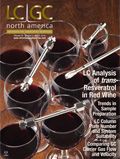BioChromatography with Reversed-Phase and HILIC Techniques
LCGC North America
A summary of what these techniques can tell us from a qualitative and quantitative perspective
The growth in the development of biopharmaceuticals to treat a wide array of diseases is well documented. Many of these products are based on proteins, viruses, and oligonucleotides and as such are inherently complex and heterogeneous.
During the development of so called originator molecules as well as in the production of generic copies (biosimilars and bio-betters), the structure of the entities needs to be fully characterized at the primary, secondary, tertiary, and quaternary levels. A list of critical quality attributes (CQAs) needs to be defined and analytical techniques employed to ensure the attributes are being met.
A wide variety of analytical techniques need to be used, and the next two installments of “The Essentials” deal with the chromatographic modes used and the information that they reveal.
Reversed-Phase Liquid Chromatography
Reversed-phase chromatography can be used to study intact as well as cleaved proteins, to gain information on purity and identification of variants whose hydrophobicity differs, typically as a result of post-translational modifications. Variants typically appear as small peaks eluted either before or after the main peak and need to be characterized to relate the type of modification to the retention time for ongoing monitoring. Di-thiothreitol and papain can be used to cleave the proteins into smaller subunits (light and heavy chains of a monoclonal antibody, for example) so that the variability can be associated with particular regions of the protein.
Due to the size and slow diffusion characteristics of the biomolecules, several tactics need to be used to avoid poor reversed-phase chromatography, including the use of highly deactivated phases combined with ion-pair reagents (trifluoroacetic acid remains the most prolific) to prevent poor peak shape because of secondary interactions with the stationary phase support; highly efficient particles with wide pores (300 Å is typical) and increased temperatures to mitigate peak broadening because of slow diffusion kinetics; and less-hydrophobic stationary phases (C4 is typical) combined with stronger elution solvents and higher temperatures to avoid long retention times. One needs to be vigilant to any artificial changes to the structure or chemistry of the analyte induced by increased temperature or pressure.
Reversed-phase chromatography coupled with mass spectrometric (MS) detection can provide more specific information on post translational modifications (for example, deamidation of an asparagine residue) or subtle changes in the make-up of the glycan (polysaccharide residue) which is critical for the efficacy for most proteins. One needs to consider the effect of ion-pairing reagents on the MS signal; for example, trifluoroacetic acid may suppress the signal and alternative ion pairing reagents may need to be used.
While reversed-phase analysis of the intact or partially fragmented protein is useful, it does not provide information on localized modifications. Typically, the protein will be digested using a chaotropic reagent such as trypsin. Reversed-phase chromatography with MS detection is then used to characterize the type and specific site of any modifications from the resulting peptides. This approach is particularly useful because post-translational modifications at critical positions on the protein may radically change the efficacy or safety of the protein.
High performance liquid chromatography (HPLC)–MS can also be used to compare the retention time, mass, and area of the peptide peaks from digested proteins with in-silico prediction models in an effort to sequence the peptides and thus identify the protein. Typically, the degree to which the in-silico model fits the experimental data is called sequence coverage; the higher the coverage, the more confidence we can have with the identification. High-efficiency stationary phases using sub-2-µm and core–shell particles are very useful in protein sequencing because high peak capacity increases the number of individual peptides that can be separated and identified, thereby improving sequence coverage.
Hydrophilic-Interaction Chromatography
Hydrophilic-interaction chromatography (HILIC) techniques are often used to characterize the N-linked glycan moieties of glycoproteins. These polysaccharide species are very important in determining protein folding and function and are complex, containing many monosaccharides, combined in core and antennary structures. The number, type, and arrangement of the monosaccharides within the glycan will affect the form and efficacy of the protein. Many commercially successful antibody protein drugs contain N-linked glycans.
Typically, the glycan will be enzymatically cleaved from the protein (typically using PNGase F) and then labeled with a fluophore, of which 2-aminobenzamide (2-AB) is the most popular. The tagging is necessary because of the lack of a UV chromophore and facilitates fluorescence detection. However, MS detection and structural characterization of the glycan moieties is now very popular.
HILIC techniques are necessary because the glycan units are highly polar and are poorly retained or separated under reversed-phase conditions. Acetonitrile gradients of 5–40% at pH 4.5 are typical, and high-efficiency particle morphologies combined with bonded polar phases are capable of separating the many possible glycan forms, which is necessary to fully characterize the protein and any impurities and variants. Often the difference between an originator protein and a bio-better may lie only in the structure of the N-linked glycan.
Get the full tutorial at www.CHROMacademy.com/Essentials (free until April 20).

Assessing Thorium-Peptide Interactions Using Hydrophilic Interaction Liquid Chromatography
February 4th 2025Paris-Saclay University scientists used hydrophilic interaction liquid chromatography (HILIC) coupled to electrospray ionization mass spectrometry (ESI-MS) and inductively coupled plasma mass spectrometry (ICP-MS) to assess thorium’s interaction with peptides.

.png&w=3840&q=75)

.png&w=3840&q=75)



.png&w=3840&q=75)



.png&w=3840&q=75)





